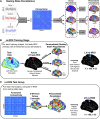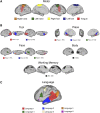A personalized cortical atlas for functional regions of interest
- PMID: 37727907
- PMCID: PMC10994647
- DOI: 10.1152/jn.00108.2023
A personalized cortical atlas for functional regions of interest
Abstract
Advances in functional MRI (fMRI) allow mapping an individual's brain function in vivo. Task fMRI can localize domain-specific regions of cognitive processing or functional regions of interest (fROIs) within an individual. Moreover, data from resting state (no task) fMRI can be used to define an individual's connectome, which can characterize that individual's functional organization via connectivity-based parcellations. However, can connectivity-based parcellations alone predict an individual's fROIs? Here, we describe an approach to compute individualized rs-fROIs (i.e., regions that correspond to given fROI constructed using only resting state data) for motor control, working memory, high-level vision, and language comprehension. The rs-fROIs were computed and validated using a large sample of young adults (n = 1,018) with resting state and task fMRI from the Human Connectome Project. First, resting state parcellations were defined across a sequence of resolutions from broadscale to fine-grained networks in a training group of 500 individuals. Second, 21 rs-fROIs were defined from the training group by identifying the rs network that most closely matched task-defined fROIs across all individuals. Third, the selectivity of rs-fROIs was investigated in a training set of the remaining 518 individuals. All computed rs-fROIs were indeed selective for their preferred category. Critically, the rs-fROIs had higher selectivity than probabilistic atlas parcels for nearly all fROIs. In conclusion, we present a potential approach to define selective fROIs on an individual-level circumventing the need for multiple task-based localizers.NEW & NOTEWORTHY We compute individualized resting state parcels that identify an individual's own functional regions of interest (fROIs) for high-level vision, language comprehension, motor control, and working memory, using only their functional connectome. This approach demonstrates a rapid and powerful alternative for finding a large set of fROIs in an individual, using only their unique connectivity pattern, which does not require the costly acquisition of multiple fMRI localizer tasks.
Keywords: fMRI; functional connectivity; functional regions of interest; individual differences; parcellation.
Conflict of interest statement
No conflicts of interest, financial or otherwise, are declared by the authors.
Figures






Similar articles
-
Predicting high-level visual areas in the absence of task fMRI.Sci Rep. 2024 May 18;14(1):11376. doi: 10.1038/s41598-024-62098-9. Sci Rep. 2024. PMID: 38762549 Free PMC article.
-
A human brain atlas derived via n-cut parcellation of resting-state and task-based fMRI data.Magn Reson Imaging. 2016 Feb;34(2):209-18. doi: 10.1016/j.mri.2015.10.036. Epub 2015 Oct 31. Magn Reson Imaging. 2016. PMID: 26523655 Free PMC article.
-
Using connectomics for predictive assessment of brain parcellations.Neuroimage. 2021 Sep;238:118170. doi: 10.1016/j.neuroimage.2021.118170. Epub 2021 Jun 1. Neuroimage. 2021. PMID: 34087365
-
Resting-state functional MRI studies on infant brains: A decade of gap-filling efforts.Neuroimage. 2019 Jan 15;185:664-684. doi: 10.1016/j.neuroimage.2018.07.004. Epub 2018 Jul 7. Neuroimage. 2019. PMID: 29990581 Free PMC article. Review.
-
Resting-state network mapping in neurosurgical practice: a review.Neurosurg Focus. 2019 Dec 1;47(6):E15. doi: 10.3171/2019.9.FOCUS19656. Neurosurg Focus. 2019. PMID: 31786561 Free PMC article. Review.
Cited by
-
Connectivity and function are coupled across cognitive domains throughout the brain.bioRxiv [Preprint]. 2025 Jul 14:2025.07.09.663763. doi: 10.1101/2025.07.09.663763. bioRxiv. 2025. PMID: 40791443 Free PMC article. Preprint.
References
-
- Brodmann K. Vergleichende Lokalisationslehre der Grosshirnrinde in ihren Prinzipien dargestellt auf Grund des Zellenbaues. Leipzig, Germany: Barth, 1909.
-
- Dickie DA, Shenkin SD, Anblagan D, Lee J, Blesa Cabez M, Rodriguez D, Boardman JP, Waldman A, Job DE, Wardlaw JM. Whole brain magnetic resonance image atlases: a systematic review of existing atlases and caveats for use in population imaging. Front Neuroinform 11: 1, 2017. doi:10.3389/fninf.2017.00001. - DOI - PMC - PubMed
Publication types
MeSH terms
Grants and funding
LinkOut - more resources
Full Text Sources

